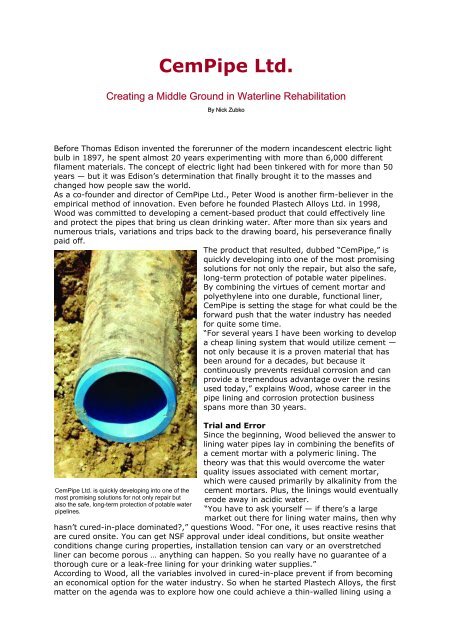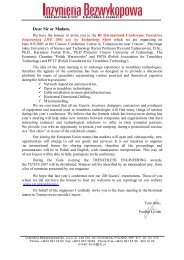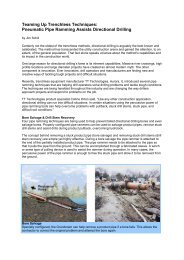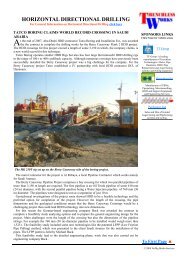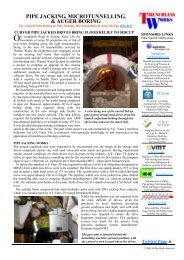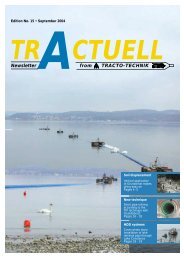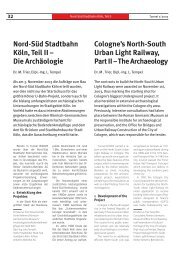CemPipe Ltd - nodig-construction.com
CemPipe Ltd - nodig-construction.com
CemPipe Ltd - nodig-construction.com
Create successful ePaper yourself
Turn your PDF publications into a flip-book with our unique Google optimized e-Paper software.
<strong>CemPipe</strong> <strong>Ltd</strong>.<br />
Creating a Middle Ground in Waterline Rehabilitation<br />
By Nick Zubko<br />
Before Thomas Edison invented the forerunner of the modern incandescent electric light<br />
bulb in 1897, he spent almost 20 years experimenting with more than 6,000 different<br />
filament materials. The concept of electric light had been tinkered with for more than 50<br />
years — but it was Edison’s determination that finally brought it to the masses and<br />
changed how people saw the world.<br />
As a co-founder and director of <strong>CemPipe</strong> <strong>Ltd</strong>., Peter Wood is another firm-believer in the<br />
empirical method of innovation. Even before he founded Plastech Alloys <strong>Ltd</strong>. in 1998,<br />
Wood was <strong>com</strong>mitted to developing a cement-based product that could effectively line<br />
and protect the pipes that bring us clean drinking water. After more than six years and<br />
numerous trials, variations and trips back to the drawing board, his perseverance finally<br />
paid off.<br />
The product that resulted, dubbed “<strong>CemPipe</strong>,” is<br />
quickly developing into one of the most promising<br />
solutions for not only the repair, but also the safe,<br />
long-term protection of potable water pipelines.<br />
By <strong>com</strong>bining the virtues of cement mortar and<br />
polyethylene into one durable, functional liner,<br />
<strong>CemPipe</strong> is setting the stage for what could be the<br />
forward push that the water industry has needed<br />
for quite some time.<br />
“For several years I have been working to develop<br />
a cheap lining system that would utilize cement —<br />
not only because it is a proven material that has<br />
been around for a decades, but because it<br />
continuously prevents residual corrosion and can<br />
provide a tremendous advantage over the resins<br />
used today,” explains Wood, whose career in the<br />
pipe lining and corrosion protection business<br />
spans more than 30 years.<br />
<strong>CemPipe</strong> <strong>Ltd</strong>. is quickly developing into one of the<br />
most promising solutions for not only repair but<br />
also the safe, long-term protection of potable water<br />
pipelines.<br />
Trial and Error<br />
Since the beginning, Wood believed the answer to<br />
lining water pipes lay in <strong>com</strong>bining the benefits of<br />
a cement mortar with a polymeric lining. The<br />
theory was that this would over<strong>com</strong>e the water<br />
quality issues associated with cement mortar,<br />
which were caused primarily by alkalinity from the<br />
cement mortars. Plus, the linings would eventually<br />
erode away in acidic water.<br />
“You have to ask yourself — if there’s a large<br />
market out there for lining water mains, then why<br />
hasn’t cured-in-place dominated,” questions Wood. “For one, it uses reactive resins that<br />
are cured onsite. You can get NSF approval under ideal conditions, but onsite weather<br />
conditions change curing properties, installation tension can vary or an overstretched<br />
liner can be<strong>com</strong>e porous … anything can happen. So you really have no guarantee of a<br />
thorough cure or a leak-free lining for your drinking water supplies.”<br />
According to Wood, all the variables involved in cured-in-place prevent if from be<strong>com</strong>ing<br />
an economical option for the water industry. So when he started Plastech Alloys, the first<br />
matter on the agenda was to explore how one could achieve a thin-walled lining using a
<strong>com</strong>bination of cements, plastics and adhesives. As Wood came to find out, that feat was<br />
easier said than done.<br />
“I wanted to design a durable, ultra-thin liner and we believed the best route to achieve<br />
that was cement and PE [polyethylene],” recalls Wood. “But the problem with<br />
polyethylene, of course, is that you can’t really glue it to anything short of heating and<br />
melting it because it’s a waxy type of material. So the best way to get a bond was to find<br />
a PE material that could mechanically lock to the cement.”<br />
While beginning his experimentation at Plastech Alloys, Wood was approached by the<br />
U.K.’s Water Research Centre (WRc), which had filed for patents on a cement-based<br />
cured-in-place felt material. The two <strong>com</strong>bined efforts and attempted to incorporate the<br />
patented technology into Wood’s work.<br />
“We had a certain measure of success along that route — particularly by taking the felt<br />
and making it castellated, or in other words like little ridges in the felt,” says Wood. “But<br />
with the cement being so heavy, the tubes were difficult to handle and the polyester<br />
fibers tended to filter water from the cement — which was very cumbersome.”<br />
Plastech Alloys then approached Pipeway <strong>Ltd</strong>., a U.K.-based pipe lining contractor, which<br />
at the time was owned by French water <strong>com</strong>pany Saur, to help develop the technology.<br />
The incorporation of <strong>CemPipe</strong> <strong>Ltd</strong>. soon followed, along with a license agreement with<br />
WRc. Over a four-year development period working with Pipeway (specifically Mike<br />
Broadwood), the <strong>CemPipe</strong> product was taken through more than 50 incrementally<br />
different incarnations.<br />
“Like most things in the lining business, you have to develop the product empirically,”<br />
says Wood. “You need to physically experiment and demonstrate it and measure its<br />
performance to see how it works, but you can only ac<strong>com</strong>plish that by trial and error —<br />
you <strong>com</strong>e up with something that you think will work, then you put it in and monitor it to<br />
see where changes need to be made. You progressively change [the design], you don’t<br />
just sit down with a pen and paper one afternoon, design it and say, ‘Well, there it is.’ It<br />
doesn’t work that way.”<br />
Primary design considerations included the method of tube manufacture, the design and<br />
testing of installation fittings and a unique rounding device called a parachute pig. First<br />
off, Wood wanted a leak-free tube. Second, to ensure that once a line was grouted, the<br />
cement was distributed all the way around the pipe. After rigorous testing with different<br />
locking mechanisms, <strong>CemPipe</strong>’s designers finally came up with the idea to give Velcro a<br />
try.<br />
Further investigation revealed that a Velcro product could in fact be produced with a<br />
water industry-approved PE material. Incorporating a mechanical hook arrangement, the<br />
polymeric layer could bond to the cement mortar and provide the correct depth of<br />
cement mortar application within the pipe.<br />
“In terms of development, incorporating the Velcro material was one of our biggest steps<br />
forward,” Wood recalls. “Velcro used the same machine that it uses to make the<br />
polypropylene hooks used for diapers. We wanted to make it out of polyethylene, which<br />
Velcro was able to do for us, so that was a big achievement.”<br />
Keeping It Simple<br />
The top criteria for <strong>CemPipe</strong> was to develop a leak-free, gun-barrel liner that could repair<br />
defects such as leaks in the host pipe, maintain water quality and provide active<br />
corrosion protection. But even from the beginning, it was also critical to create a process<br />
that was as simple and straightforward as possible.
The process involves insertion of a folded tube into<br />
the main, which is manufactured in a flat form with<br />
grout key hooks on one face. The tube is pulled<br />
into the host pipe from an excavated point of<br />
access with a device that folds the tube into a “C”<br />
configuration. Once the tube has been fully<br />
extended within the host main, installation fittings<br />
are attached and cement mortar introduced.<br />
The tube and cement mortar are rounded and<br />
expanded under pressure, forcing some of the<br />
cement mortar into any existing holes or gaps<br />
created by misplaced joints, and — in the case of<br />
bell and spigot joints — the sealing of these joints<br />
where joint packing fails. Pressure is applied to a<br />
Peter Wood, co-founder and director <strong>CemPipe</strong> <strong>Ltd</strong>. (center),<br />
is <strong>com</strong>mitted to bringing his product to new markets. Here, he<br />
is talking up his product at the recent Hamburg No-Dig show.<br />
parachute pig as it moves down the pipe, expanding as the cement mortar fills any voids<br />
around the grout key hooks. Pressure is maintained by holding the tube and the cement<br />
mortar against the host main until the cement hydrates. After approximately 16 hours,<br />
return to service procedures can be carried out and the services reconnected.<br />
“A unique thing about <strong>CemPipe</strong> is that it’s so damn simple,” Wood explains. “People look<br />
at it and think that it’s too simple to even work, but it took a long time and a lot of effort<br />
to develop the simplicity into the process that we have now. And based on my<br />
experience, contractors have found it expensive to get into the lining business because of<br />
the money spent on special equipment. So we also wanted to keep the technology simple<br />
to minimize the cost of special equipment.”<br />
<strong>CemPipe</strong> is ideal for countries where the use of local labor<br />
is encouraged because installation training is quick.<br />
The system was also designed to be as contractorfriendly<br />
as possible. The <strong>CemPipe</strong> system requires<br />
low capital expenditure on specialty equipment, a<br />
small site footprint and low bulk storage<br />
requirements — contractors can transport more<br />
than 300 m of tube in the trunk of a car and all of<br />
the installation equipment fits onto a small pickup.<br />
The cement used is available worldwide and is<br />
cheap, making it ideal for use in developing and<br />
third world countries where the use of local labor is<br />
an advantage to the client.<br />
“<strong>CemPipe</strong> is ideal for use in those countries where<br />
the use of local labor is encouraged,” Wood points<br />
out. “Installation training is quick and the skills<br />
required to install linings can be taught to unskilled<br />
workers. Given that a client in a developing<br />
country needs to rehabilitate his pressure mains,<br />
he could utilize the local labor without the need for<br />
a high expatriate contingent — thereby creating<br />
new jobs in the <strong>com</strong>munity.”<br />
Developing Markets<br />
The <strong>CemPipe</strong> liner has been in its current form for<br />
the last 18 months, integrated into water systems<br />
in the United Kingdom, Western Europe and in Russia. The product has met every safety<br />
standard for which it has been submitted, including approval under the U.K. Reg (1) (a)<br />
and BS6920 and Authorized Registered Formulation (ARF) status in the United States as<br />
of January 2001. The rapid progress led <strong>CemPipe</strong> <strong>Ltd</strong>. to buy out its partnership with<br />
Pipeway in September 2004, and has since opened tube production facilities in the<br />
Netherlands and offices in the United Kingdom and Germany.<br />
In late 2003, Pipeway, which remains a <strong>CemPipe</strong> licensee, installed <strong>CemPipe</strong> in three<br />
drinking water lines as part of a main rehabilitation program for the U.K.’s South East
Water, which supplies 1.5 million people in southeast England with more than 400 million<br />
liters of drinking water a day.<br />
“Since we put those three sections in, we’ve had no burst mains in those areas, no<br />
failures at all, which is brilliant,” says Dave Skelhorne, South East Water’s general<br />
manager. “Another advantage of the <strong>CemPipe</strong> is cost. With normal rehabilitation, we put<br />
a 50-year life on the actual lining but we don’t put any extra life on the main. With<br />
<strong>CemPipe</strong>, you extend the life of the main as well, which saves you money for a longer<br />
period of time.”<br />
<strong>CemPipe</strong> has already expanded its list of licensees into Portugal, Hong Kong, Germany<br />
and Russia, with more negotiations in progress that are likely to be concluded during the<br />
first quarter of 2005. As far as North America is concerned, <strong>CemPipe</strong> is currently<br />
investigating how to take advantage of this potentially large market. The <strong>com</strong>pany has<br />
already registered a separate U.S.-based <strong>com</strong>pany called Mainsaver Inc., in Delaware —<br />
serving as a prelude to its entry into the North American market. Their game plan has<br />
yet to be finalized, but Wood says it’s going to happen in the near future.<br />
“We’ve already developed markets in the U.K., Eastern Europe, China, but it’s the U.S.<br />
market where everyone is waiting for something to happen,” Wood says. “It’s not a big<br />
drinking water lining market at the moment — in terms of expenditure on water pipeline<br />
renovation. But with all the attention that drinking water has been getting, I think it’s<br />
ready to open up and be<strong>com</strong>e a lucrative market.<br />
“People don’t buy sewage, but they buy drinking water. And since it’s a salable<br />
<strong>com</strong>modity you have to deliver it to the customer in the right condition, at the right<br />
pressure and the right price. And that’s what we’re trying to do with <strong>CemPipe</strong>.”<br />
Nick Zubko is associate editor of Trenchless Technology


